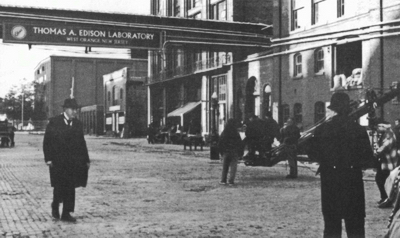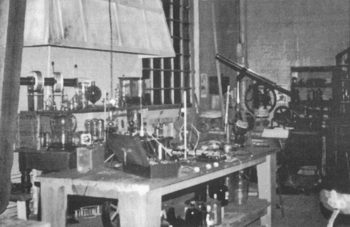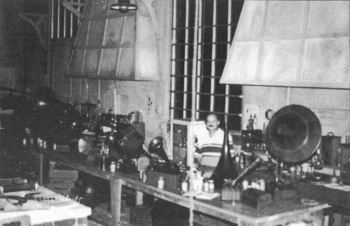|
Edison: The Wizard of Light
by Mark Caruana
Outside view of Edisonís lab as the crew sets up to film

|
|
This past September I was lucky enough
to visit Edisonís West Orange, New
Jersey lab without leaving Toronto.
What's more, I was able to visit the site in the
late 1800ís and meet Thomas Alva Edison
himself and William Dickson. Some of you
may be familiar with Dickson who deserves
much of the credit for developing and refining Edisonís Kinetoscope.
I was able to spend some time in the Black Maria (the first movie
studio) and even sneak into Edisonís private
office. This miracle was made possible by the
Devine Entertainment Co. of Canada who
were in the process of filming a fictionalized
story involving Thomas Edison.
The
Devine
Companyís
producers,
David
Devine and Richard Mozer, have previously
produced
the
prime
time
Emmy
winning
Beethoven Lives Upstairs and the well known
Composer's
Specials which won the Cable
Ace Award for Best Youth Program
in the
U.S.
as well
as the American
Librarianís
Association Award. This most recent project
is part of a childrenís series of six short films
intended to bring famous
scientists to life
through
the
eyes
of
children.
Their
first
instalment on Einstein last year was recently
followed by Leonardo:
A Dream of Flight
which aired on the Family Channel in Canada
and HBO in the U.S. This will be followed by
Galileo:
On the
Shoulders of a
Giant
in
January of 1998.
Part of the interior of Edisonís lab

|
|
Presently in production with the instalment
Edison:
The Wizard of Light, Devine and
Mozer expect to have this ready to air by
December
1998. Other
instalments
include
films about Sir Isaac Newton and Madame
Curie.
The Edison film centres around a fictional
movie director, Jack Maloney (played by
Jesse Collins), at the time of Edisonís death
in 1931. Through a series of flashbacks we
find out that Jackís interest in film making
started out in
1893, when as a 10 year old
street urchin he sneaks into Edisonís lab for
shelter.
He is discovered
by the great man
himself
(played
by
Canadian
actor
Ken
Welsh) and a friendship ensues as Jack learns
about Edisonís many famous inventions.
At this time Edison is developing the motion
picture camera and as part of his experiments
we get to see an antique Zoetrope. Eadweard
Muybridge the father of moving picture theory also demonstrates
a Zoopraxiscope
(an
early
device
designed
to
demonstrate
the
principles used to produce moving pictures.)
From these machines
Edison and Dickson
were able to develop the Kinetoscope.
Domenic setting up for a scene in Edisonís lab

|
|
Even though the series is intended for children, a great deal of care has been taken to ensure the sets and props are as authentic and
accurate
as
possible.
Devine
visited
the
Edison Lab in West Orange, New Jersey to
do
research
for
the film where he
was able to find
original
photographs
to
help
construct
the
West Orange Lab,
his office and the
Black Maria.
The site
substituted
for
West
Orange,
New
Jersey
is
located
in
downtown
Toronto at the old
Gooderham
Distillery
which
is a complex of
15 buildings built
in the mid-1800's and presently being used
by film companies needing to recreate this
period.
The day
I first
visited the set
an
episode of the YTV series Goosebumps was
being filmed. This complex makes an incredible backdrop for many of the street scenes in
the film. Standing at the centre of the cobblestone streets with much of the modern city
blocked
by the
buildings,
gives
an
overwhelming sense of what the city was like in
the 1800s. Add to that the set decorations,
horse drawn carriages and the extras dressed
in period costumes and you get a feel for how
good this film will look.
Edisonís office

|
|
As you can imagine recreating Edisonís lab
required a great deal of research, not to mention
some
expensive
props.
With
the
University of Toronto who providing most
the old glass and lab equipment, and some
very
creative
carpentry,
the
finished
lab
looked very authentic. To this was added a
wide variety of phonographs and cylinders
from
the
collection
of
CAPS
member
Domenic
DiBernardo.
These
phonographs
ranged
from many
parts
machines
strewn
about the lab as experiments in progress, to a
few complete original machines.
An unusual machine used in the movie was
an
original
Edison
talking
doll, which plays
a
prominent
role
early in the film.
At one
point
in
the scene Michal
Suchanek
who
plays
Jack
as
a
child,
is
startled
by
the
doll's
voice
and
drops
the
doll.
There
were a few tense
moments during
filming
when
Michal
went
to
drop
the
doll
thinking
it was a
cheap
substitute.
Unfortunately,
I was not able to get a photo of
Domenic when the director cued the actor to
drop the doll on the concrete floor just as one
of the crew was informing him of the actual
value of the doll. Luckily nothing was broken.
Also carefully recreated was Edison's office.
Although a few of us will notice minor errors
in the props used, the office still had an air of
authenticity.
A Street scene showing Jack as a street urchin

|
|
To create the Black Maria set, antique movie
camera
collector
Robert
Gutteridge
was
enlisted
to
provide
several
authentic
film
props and build a few
reproduction
pieces.
As with the lab set, a great deal of research
was done to ensure its authenticity. Replicas
of equipment such as an Edison Kinetoscope
were used where it was not possible to have
the actors damage
a real one as part of a
scene.
Other
locations
used
in the film
included
Spadina
House
beside Toronto's
historic
Castle Loma. The Spadina
House's
striking
similarity
to
Edisonís
West
Orange
home
"Glenmount"
made
it an ideal location for
filming.
Unfortunately
we will
have
to wait
until
December
1998 to see this film but as the
date draws nearer, we will attempt to find out
exact premier dates and
times for HBO
in the
U.S.
and
the
Family
Channel in Canada. As
with
all
the
programmes in this series,
they may be purchased
privately,
or
by
libraries
and
schools
through
Devine
Entertainment.
When
the film is released we
will
make
available
information on how to
order this film.
I
would
like
to
thank
Devine
Entertainmentís, David Devine and in particular Donald Benett (who handled the props
for the
movie) for
allowing
me to snoop
around the
set and take some great pictures.
|